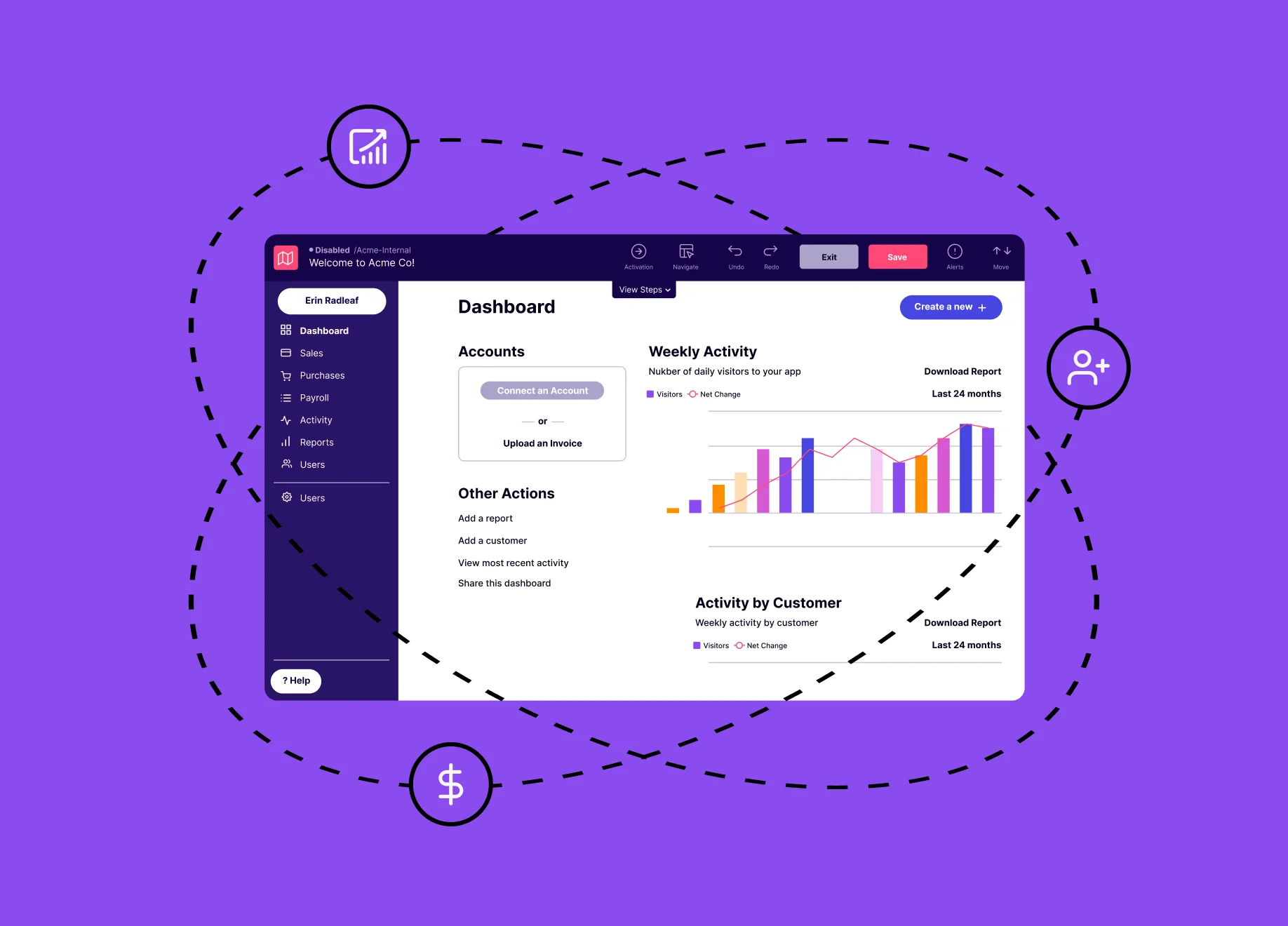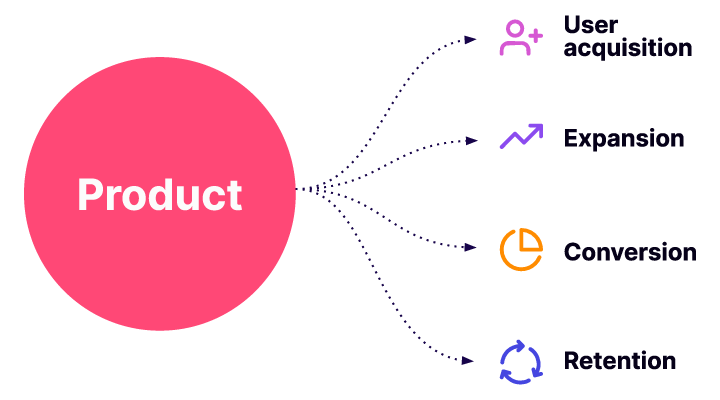Inhaltsverzeichnis
Was bedeutet produktorientiertes Wachstum?
Product-led growth describes a business strategy that places a company’s software at the center of the buying journey—and often at the center of the broader customer experience. A product-led growth strategy counts on the product itself—its features, performance, and virality—to do much of the “selling.”
Was macht produktbasiertes Wachstum einzigartig?
Das Hauptunterscheidungsmerkmal des produktgesteuerten Wachstums besteht darin, dass das Produkt im Mittelpunkt der Markteinführung steht. In produktgesteuerten Unternehmen richten sich die Vertriebs- und Marketingteams neu aus und überlassen dem Produkt (sowie dem positiven sozialen Feedback, das es generiert) die Führung.
Für Unternehmen, die ein Freemium-Produkt anbieten, wird das Produkt selbst zu einem Verkaufs- und Marketinginstrument, da es neue Benutzer anzieht, ohne dass Geld für Werbekampagnen oder zusätzliche Vertriebsmitarbeiter ausgegeben werden muss. In ähnlicher Weise erlauben produktbasierte Wachstumsstrategien den Nutzern oft, ein Produkt kostenlos zu testen, mit der Absicht, ihnen einen ausreichenden Mehrwert zu bieten, um sie zu einem Upgrade auf die kostenpflichtige Version zu bewegen.
Warum ist produktbasiertes Wachstum wichtig?
As companies grow and the amount of customers and prospects it engages with expands, a 1:1 human-to-human support and sales model becomes less and less sustainable. Product-led growth helps companies continue to scale and grow efficiently by automating some of the key onboarding, support, sales, and marketing functions and letting customers and prospects engage with them in the app itself. In doing so, it frees the humans in a company up to pursue more strategic, meaningful work while having confidence that users of all categories are getting the support and information they need. In other words, product-led growth is not a substitute for human support and ingenuity, but rather a complement to it.
5 PLG-Strategien, die Ihrem Unternehmen zum Erfolg verhelfen
Was steckt hinter produktbasiertem Wachstum?
The term “product-led growth” was originally coined in 2016 by Blake Bartlett at OpenView, although the principles that define it had been around before that. What drove the rise of product-led growth were companies experimenting with various ways (“freemium” product models, self-guided tours, etc.) to simultaneously grow and be profitable. In traditional growth models, growth and profitability existed as a dichotomy. Pursuing one came at the expense of the other. Product-led growth overcame this dichotomy, with the companies embracing the tactics and strategies that would become associated with the term seeing unprecedented levels of success in both.
Wie steigern Self-Service-Testversionen oder Freemium produktorientiertes Wachstum?
Often central to a product-led growth strategy is a self-service trial or freemium option that allows a prospective customer to evaluate the product independently and without charge, bounded by time and/or functionality, and often without engaging a salesperson. This self-service approach aligns to shifting changes in buyer preferences, particularly in the research and evaluation phases of the buying journey. Many buyers want to try before they buy, relying less on a salesperson’s assistance than on their own first-hand experience with the product, in conjunction with customer and social proof that they discover via review sites and social networks.
Many companies use these trial and freemium experiences to measure product usage and engagement, scoring leads and timing and targeting conversion offers and sales outreach accordingly. Citrix, for example, used product analytics to identify a certain trial usage pattern that converted to paying customers at a higher rate than others. The team then created an onboarding flow that steered trial users toward those particular features, and was able to increase their trial conversion rate by 28 percent.
OpenView, eine führende VC-Firma, die sich auf Softwareunternehmen in der Expansionsphase konzentriert, sieht die Bedeutung des produktbasierten Wachstums und des Freemium-Modells darin:
Wie reduziert produktorientiertes Wachstum die Kundenakquisitionskosten?
Eine produktorientierte Wachstumsstrategie kann sich positiv auf die Kundenakquisitionskosten (CAC) auswirken, da die Belastung der Verkaufsteams verringert wird. Vertriebs- und Marketingkosten tragen zu den Kundenakquisitionskosten bei. Je mehr Druck nach unten ein Unternehmen auf diese Kosten ausüben kann, desto besser werden die Effizienzkennzahlen wie die CAC.
Was ist eine produktbasierte Wachstumsstrategie?
Bei einer produktbasierten Wachstumsstrategie steht das Produkt im Mittelpunkt des Geschäftswachstumsmodells eines Unternehmens. Wie die Strategie in der Praxis aussieht, hängt vom Unternehmen ab. Bei einer produktbasierten Wachstumsstrategie steht das Produkt im Mittelpunkt des Geschäftswachstumsmodells eines Unternehmens. Im Rahmen einer solchen Strategie können Ziele für wichtige Wachstumskennzahlen festgelegt werden, z. B. ein bestimmter Prozentsatz an neuen Umsätzen, die Anzahl oder der Prozentsatz der Leads für neue Geschäftsmöglichkeiten, der Umfang des Funktions- oder Nutzungswachstums bei bestehenden Kunden usw., die durch produktbasierte Maßnahmen wie Freemium-Versionen, selbstgesteuerte Demos und In-App-Benachrichtigungen über neue Funktionen und Produktangebote erreicht werden. Je stärker der Vertrieb, das Marketing und der Support durch das Produkt selbst vorangetrieben werden, desto stärker tendiert ein Unternehmen zu einer produktbasierten Strategie.
Wie binde ich produktorientiertes Wachstum in die produktorientierte Strategie meines Unternehmens ein?
Product-led growth is a subset of a broader product-led strategy, which expands beyond the try/buy phase of a self-service buying journey to include other touch points, pre- and post sales, where the product takes center stage. For example, a product-led strategy may also mean bringing aspects of sales, marketing, service, support, and education inside the product for convenience, reduced friction, and greater contextual relevance to end users. Here, business functions and customer interactions that were previously executed through other channels converge inside the product, all toward the goal of making the product more useful, more engaging and, ultimately, more valuable for customers and end users.
Welche Beispiele gibt es für produktbasiertes Wachstum?
Different companies embrace product-led growth in different ways. Citrix, for example, created personalized onboarding messaging for the free trial version of its ShareFile product based on the reasons users created an account. Using in-app messaging to speak to users’ specific needs, they saw a 60% increase in free trial conversions. Covetrus, meanwhile, leveraged product analytics to better understand user behaviors, created in-app guidance and onboarding based on those insights, and solicited feedback in-app so that customer priorities became their own.
Wie kann ich mehr über produktorientiertes Wachstum erfahren?
Pendo published a comprehensive e-book on how to create a product-led organization, which is available for download here. It has also created a Product-led Hub full of insightful content on leveraging a company’s product to drive growth and a stronger business.
Using product-led strategies to improve customer retention and expansion





